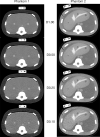Comparison of acquisition and iterative reconstruction parameters in abdominal computed tomography-guided procedures: a phantom study
- PMID: 34993078
- PMCID: PMC8666743
- DOI: 10.21037/qims-21-328
Comparison of acquisition and iterative reconstruction parameters in abdominal computed tomography-guided procedures: a phantom study
Abstract
Background: Many computed tomography (CT) navigation systems have been developed to help radiologists improve the accuracy and safety of the procedure. We evaluated the accuracy of one CT computer-assisted guided procedure with different reduction dose protocols.
Methods: A total of 128 punctures were randomly made by two operators on two different anthropomorphic phantoms. The tube voltage was fixed to 100 kVp. Tube currents (mAs) were defined to obtain 4 dose levels: 180 mAs (D1.00), 90 mAs (D0.50), 45 mAs (D0.25) and 15 mAs (D0.10) with respective volume CT dose index (CTDIvol) of 7.02, 3.52, 1.75 and 0.59 mGy. The raw data were reconstructed using level 2 of advanced model-based iterative reconstruction (ADMIRE) (A2) for D1.00, A3 for D0.50, A4 for D0.25 and A5 for D0.10. Two 12-mm targets per phantom were selected. The mean Euclidean distance (EuD) between the tip of the needle and the isocenter of the target was measured for each puncture. The different measures were compared by paired Student's t-tests.
Results: The mean EuD was 7.0±3.1 mm for the 128 punctures performed. Regardless of which phantom was considered, no significant difference in accuracy occurred between the 4 dose levels, which were 7.1±3.5 mm for D1.00; 7.1±3.1 mm for D0.50; 7.2±3.0 mm for D0.25 and 6.6±2.6 mm for D0.10.
Conclusions: Abdominal CT-guided procedures, using computer-assisted navigation and iterative reconstruction algorithms, allow precise punctures on anthropomorphic phantoms with a dose reduction of -92% compared to a standard protocol.
Keywords: Imaging guided biopsy; computer-assisted; image reconstruction; low-dose computed tomography (low-dose CT); noise reduction.
2022 Quantitative Imaging in Medicine and Surgery. All rights reserved.
Conflict of interest statement
Conflicts of Interest: All authors have completed the ICMJE uniform disclosure form (available at https://dx.doi.org/10.21037/qims-21-328). Dr. RL serves as an unpaid deputy editor of Quantitative Imaging in Medicine and Surgery. The other authors have no conflicts of interest to declare.
Figures






References
LinkOut - more resources
Full Text Sources
